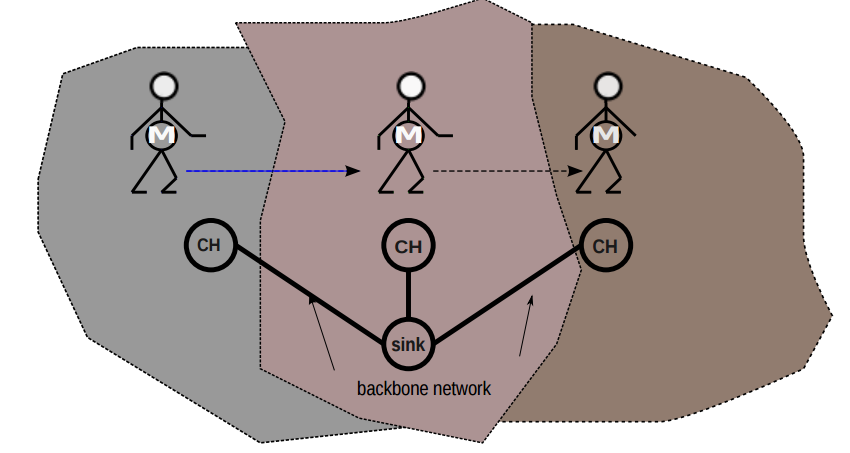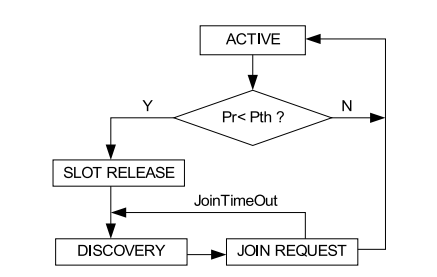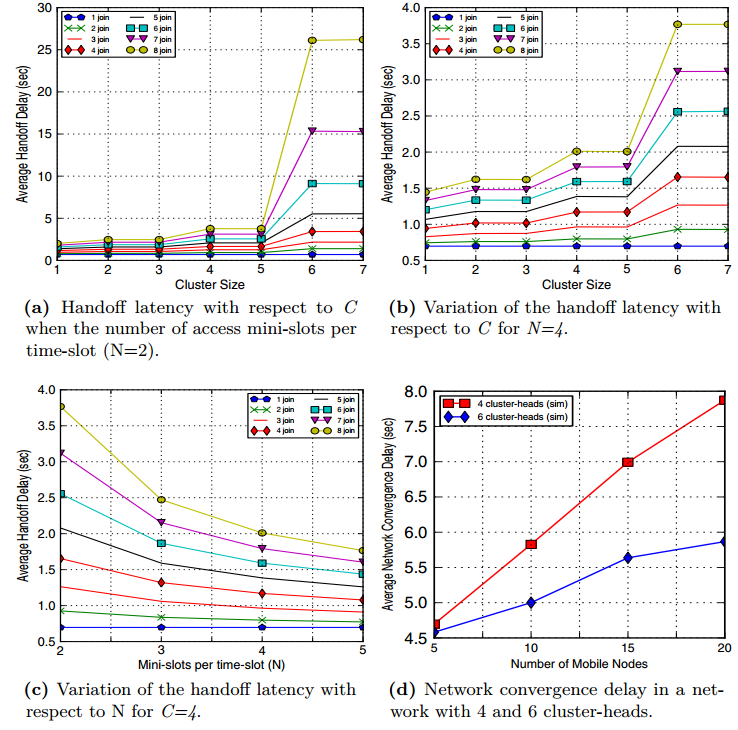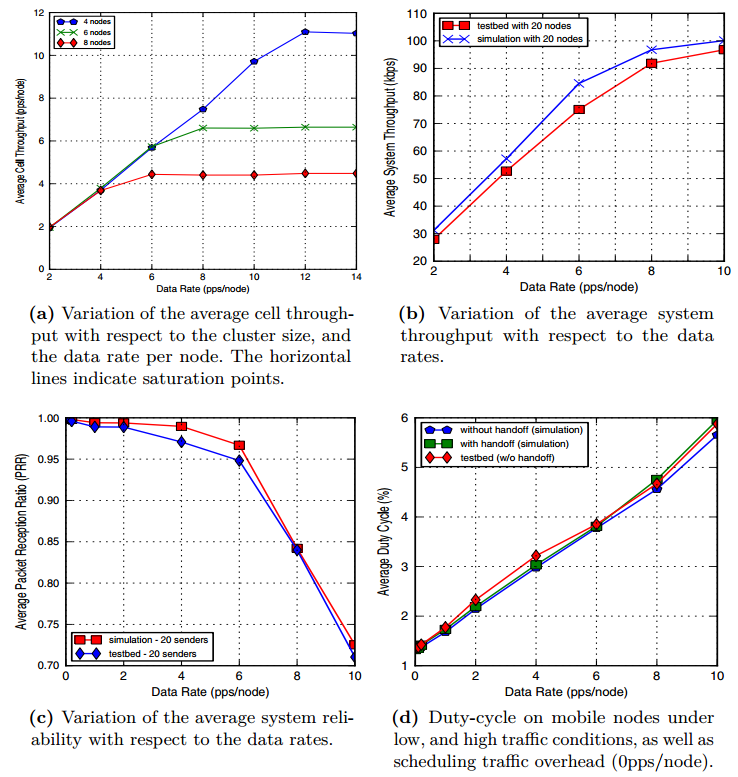Mobisense: Micro-mobility in low-power wireless networks
 |
Introduction
An increasing number of sensor network applications share a common pattern: mobile sensor and actuator nodes move freely in an area that can be covered by a backbone of stationary nodes. In these applications, sensor nodes are deployed on mobile objects such as animals, goods, or humans, to track their activities.
The common setting of these applications is micro-mobility, i.e., the movement of nodes is confined to a limited area such as a floor or a building. Due to their mobility, sensor nodes need to frequently select a new routing parent from the set of stationary backbone nodes (concurrent joins and failures).
Requirements
Reliable mobile sensing with low-latency communication and handoffs
Energy-efficient communications
High throughput
Dynamic and distributed management
Two-way communications
Architecture overview
MobiSense is a hybrid architecture combining a fixed infrastructure network and mobile sensor nodes (see Figure above). The system automatically organizes nodes into a cluster-tree topology and exploits multi-channel communication to ensure contentionfree clusters.
Our design has been driven by the following concerns:
rapidly changing link dynamics associated with mobile node movement cause the network to experiment a high degree of handoffs (join/leave requests) of mobile nodes.
central management of a contention-free network schedule for every node that hands off or propagating every join request to the manager is energy prohibitive.
enabling high throughput or maintaining a network schedule conflict-free in a large high churn network under single-channel communication is impractical.
many systems also need downlink communication, be it for dissemination of actuator commands, remote reconfiguration of mobile nodes, or simply to enable IP-based communication from mobiles to gateway.
An energy-efficient micro-mobility architecture
Minimizing handoff latency and overhearing
 |
An example of the Rapid Network Information Gathering scheme used in MobiSense. During the Network Discovery Slots, each cluster-heads broadcast small probe messages on a common channel. Nodes in the DISCOVERY state listen to those probe messages for a rapid network information gathering. |
Rapid network information gathering:
MobiSense eliminates unnecessary overhearing by introducing network discovery ND slots (see Figure) in which the sink and the cluster heads advertise information on a common channel.
ND message from a cluster-head is sent at a well-defined power level and contains information about the channel it uses for communication, the current cluster size and the timing of its access window.
Mobiles that want to join the network, or hand off from one backbone node to another, listen to these slots to gather network information and build prioritized lists of access points based on received signal strengths and cluster sizes.
Advantages
it eliminates the need to scan all 16 channels to find the network (hence minimizes overhearing).
allows for a constant network discovery delay.
it prevents unsuccessful join attempts to clusters that are already full.
Rapid network (re)admission and convergence
To save energy at backbone nodes, MobiSense dynamically adjusts the access window size (AW), i.e. the number of mini-slots in the access period.
 |
An example of a cluster-head sub-frame that shows the synchronization slot, the downlink slots, the scheduled slots, and the access mini-slots. A mobile node attempts to join that cluster after selecting a random access mini-slot |
As the cluster size grows (i.e. the amount of remaining resources decreases) we decrease the access window to allow the backbone node to enter sleep mode earlier. Specifically, let Cmax and C be the maximum and current cluster size, respectively. Then, we allocate

time slots for the access window. Each time-slot in AW is further subdivided into
 mini-slots, creating a total of
mini-slots, creating a total of

mini-slots.
Handoff
 |
MobiSense handoff scheme: a mobile node constantly monitors the received power from its cluster-head. If the received power is below the sensitivity threshold, it first announces its departure from that cluster, and secondly, it listens on a common channel during a constant number of slots to search for a new cluster. Excessive overhearing on multiple channels is avoided, while the discovery delay is constant. |
In MobiSense mobile nodes themselves decide if and when to hand off, and the ND messages allows it to gather sufficient information to make an informed handover decision.
This technique eliminates signaling overhead between the backbone nodes involved in the handover.
A node triggers a handover decision when the RSSI of packets from the current cluster-head drops below a power threshold of −75dBm.
Results
MobiSense achieves a low handoff-latency and high throughput while maintaining high reliability and energy-efficiency.
Handoff Latency
The handoff latency is divided into two parts: (i) discovery, and (ii) (re)admission latencies. The discovery latency is a constant delay, because nodes use network discovery slots. However, the (re)admission delay is not deterministic and depends on two factors: first, cluster heads synchronize their children on different phases, adding random offsets. Second, when multiple nodes are requesting admission the same cluster, collisions might occur, increasing the admission delay.
We evaluate the worst case scenarios, i.e., a number of nodes move from one cluster to another at the same time and trigger the handoff requests simultaneously.
Convergence Latency
We place mobile nodes in random starting positions and vary both the number of mobile nodes and the number of cluster-heads in the network.
 |
We vary the cluster size from 1 to 7 and vary the number of mobile nodes that join that cluster from 1 to 8. Note, that we configured MobiSense for a maximum of 8 mobile nodes per cluster. Since the cluster size determines the access window (AW), the goal is to observe how the variation of the access window and the size of number of admission mini-slots affects the handoff latency.
Throughput, Reliability & Duty-Cycle
Throughput
Multi-channel communications and clustering allows to segment the network into small contention-free and dynamically scheduled clusters. By minimizing the broadcast domain of nodes we achieved high throughput, as neighboring clusters do not need to content for medium access.
In both simulation and testbed the system throughput increases linearly with the data rate, until it reaches the saturation point of the system when the capacity of the backbone reaches its limit. Overall, we believe that these throughput rates are well within the application requirements and can even handle sudden traffic bursts.
 |
Reliability
MobiSense reaches a multi-hop reliability of more than 95% when traffic is not saturated. After passing the saturation point of 6pps reliability degrades. Although the system can accept more traffic than 6pps, we observe that the buffers at the cluster-heads become saturated, resulting in an increase of discarded packets
Duty-Cycle
We evaluate (1) the duty cycle of MobiSense under low and high traffic scenarios, and (2) the overhead of control traffic, i.e., time synchronization, scheduling.
Scheduling and signaling overhead: In the first scenario, we operate the system without data transmission. The goal was to observe how much the synchronization and control traffic contributes to the overall network duty-cycle. In the Figure above this corresponds to 1.31% at 0pps. At this point, the only traffic generated is control traffic such as keep alive messages from children to their parents to maintain schedules, and synchronization packets from parents to their children.
Low and hight traffic: under low traffic scenarios, by doubling the data rate from 0.1pps/node to 0.2pps/node, mobile nodes experience duty-cycles of 1.31% and 1.35% respectively. The later cost increases only 2% relatively to the first (1.31%), with 50% increase in the node data rate. This demonstrates that MobiSense is very energy efficient. For high data rate scenarios, the duty-cycle increases linearly with the data rate, and it still below 6% for data rates of 10pps/node
Limitations
There are two main limitations in MobiSense:
Scalability: the current system is designed to test micro-mobility in WSNs. Hence, our implementation only allows for one level of cluster heads.
Synchronization overhead: changes in traffic demands of mobile nodes inside a cluster or the arrival or departure of a mobile node trigger changes on the schedule of all nodes in a cluster. These changes are propagated to child nodes through the synchronization packet, allowing a node to react immediately to changes of its transmission schedule. This requires every node to listen to synchronization packets transmitted by its cluster-head in each super-frame. However, this causes extra energy consumption in low traffic scenarios when a node does not have any data to send to its clusterhead during consecutive super-frames.
[Code]
References
A. Gonga, O. Landsiedel, and M. Johansson, “MobiSense: Power-efficient micro-mobility in wireless sensor networks”, in Proc. of the IEEE Conference on Distributed Computing in Sensor Systems and Workshops (DCOSS’11), 2011
A. Gonga, M. Johansson and A. Dunkels, “Poster Abstract: MobiSense: power-efficient micro-mobility in IPv6-based sensor networks”, In Proc. of the
 ACM/IEEE International Conference on Information Processing in Sensor Networks (IPSN’10), April, 2010, Stockholm
ACM/IEEE International Conference on Information Processing in Sensor Networks (IPSN’10), April, 2010, Stockholm